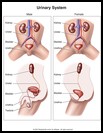
Voiding Cystourethrogram
What is a voiding cystourethrogram?
A voiding cystourethrogram is a test that uses X-rays to take pictures of the urinary system. It shows how well the bladder and its connecting tubes (called the urethra and the ureters) are working.
What happens during the test?
Your child will have one X-ray film taken of the abdominal (belly) area. This is called a scout film. Then, a urinary catheter (a small, thin, soft tube) will be inserted into the bladder. It is inserted through the opening where your child's urine comes out.
The catheter is used to fill your child's bladder with a special clear liquid called contrast. This contrast is easy to see on X-rays. X-ray pictures are taken and viewed on a television screen by the radiologist. When the bladder is full, your child will be asked to urinate and pictures will be taken of the emptying process. The catheter tube will then be removed.
Your child will be less afraid if you explain what will happen before the procedure. Depending on the age of your child, you may use books, demonstration, or dolls. The radiologist may ask if you want to stay during this procedure to provide comfort to your child. It is a good idea to bring toys to help your child relax during the insertion of the catheter.
What happens after the test?
After the test, your child may return to normal daily activities.
Your child's urine may be pink colored the first time he or she urinates after the catheter tube is removed. Your child may even cry and complain of pressure with the first urination. This is caused by a small amount of blood in the urine. If these symptoms persist or if your child cannot urinate, call your child's doctor. Usually by drinking a couple of large glasses of water or other clear liquids the child can urinate without a problem. If the child complains of a mild burning, place him or her in a bathtub of warm, plain water to urinate.
When should I call my child's doctor?
Call your child's doctor IMMEDIATELY if:
- Your child complains of severe abdominal pain.
- Your child has a fever over 101°F (38.3°C) rectally.
- Your child's urine is bright red.
- Your child has not urinated 4 hours after the catheter was removed.
Call your child's doctor during office hours if:
- Your child continues to complain of burning with urination 24 hours after the procedure.
- Your child continues to have pink-tinged urine.
- You have any questions about the procedure or the results.

